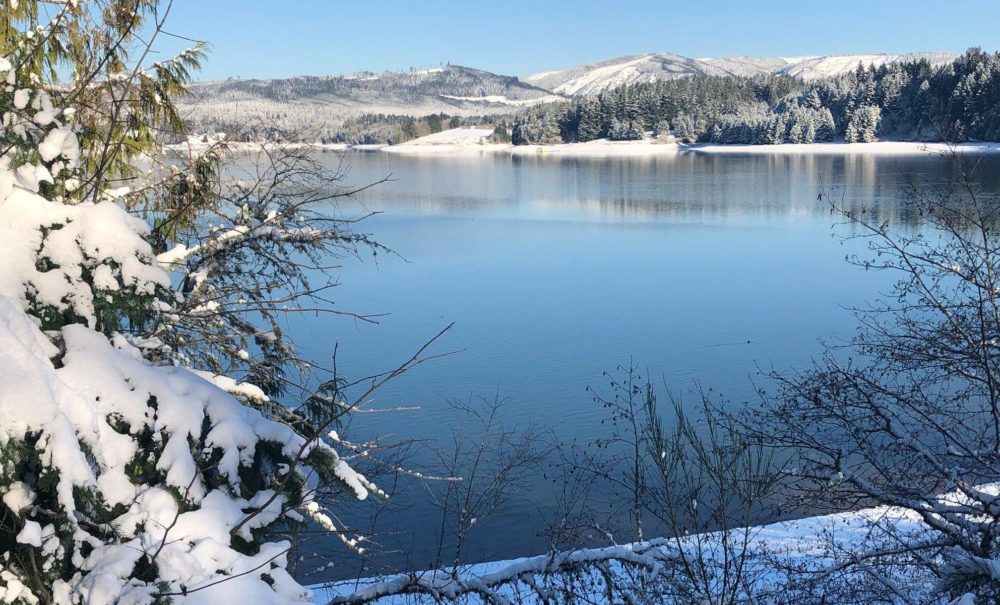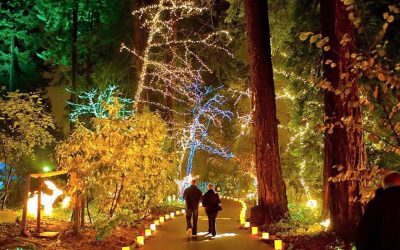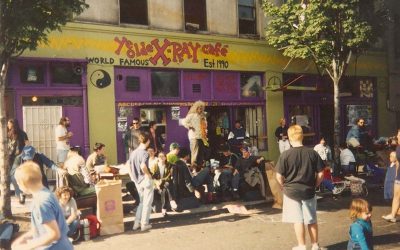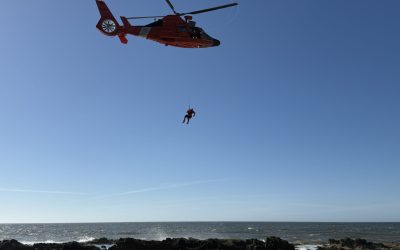My family history resides both IN and around Henry Hagg Lake. Every kid in Oregon has THAT lake they grew up with. Hagg is mine. "Hey, let's go cool off at the water later!" Many a Forest Grove summer heat was survived by heading up to the man-made reservoir a few miles out of Gaston, Oregon.
Our history goes deeper than that though. Much "deeper". In writing this article I've descended down a rabbit hole of family roots, legend, and the truth of what lies beneath the lake waters.
Henry Hagg Lake was created by flooding the area known as Scoggins Valley.

An early map showing proposals for Scoggins Valley and Hagg Lake, then known as "Scoggins Reservoir". / Image via / Pacific University Collections
By the time I was an awkward, nerdy preteen attending Tom McCall Middle School I'd heard the rumors. "Don't go swimming in Hagg Lake...there are BODIES." "Did you know there's a whole GRAVEYARD under there?" "Yo...I was swimming at Hagg one time and a SKELETON HAND reached up and grabbed my leg. FOR REALS." Preteen-me just laughed it off, but secretly my spine was developing chills. Their words nagged at me for weeks until one weekend I finally asked my mom about what I was sure were some kind of Hagg Lake zombies. Of course, mom had a somewhat more reasonable explanation.
She grew up out there, rambling around the valley in the filbert orchards, playing with cap guns, and climbing trees. In the 1950s, Hagg Lake wasn't even a thought. Where the lake is now was just a creek, the Stimpsons Lumber Camp, many homes, a log church, grist mill, and the rural schoolhouse that mom attended: Forest Dale School.
Do you love Oregon?
Sign up for monthly emails full of local travel inspiration and fun trip ideas. In each newsletter we'll share upcoming events, new things to do, hot dining spots and great travel ideas.

Forest Dale School, the remains of which now lay submerged beneath Henry Hagg Lake, Scoggins Valley, Oregon. Image via Dan Scott.
As one area old-timer recalls, "They had to tear it down because of the dam. We would go to school one day and the next day your friend's house was a pile of burning rubble. They tore down many houses to make the dam." The class of 1970 was the last to see the inside of the old schoolhouse before it was razed.
Before my ancestors settled the area though, we need to reach further back in time.
The Tualatin Plains has seen thousands of years of rich history.
For millennia, the Atfalati peoples lived in the Scoggins Valley area on what became known to early white settlers as the Twality Plains. Evidence of winter village complexes, characteristic of these Tualatin Peoples, date back roughly 6,000 years. They hunted, fished, traded, and gathered the abundant blue-flowered tubers known as Camassia. No doubt they also laid to rest their deceased loved ones in this fertile valley of the Tualatin River. As early as 1842, white Oregon pioneers began trickling into the valley, displacing the natives.

A portion of the Gibbs Starling map of 1851 showing the land of the Atfalati People. Hillsboro is near the top of the map, and at this point in white history the Scoggins Valley area was encompassed by the "Reservation of The Tualatin Band of the Calapooya Tribe".
One of these early settlers was Hiram Warner Scott. Born in Missouri in 1856, he and his wife Olive appear on the 1905 Washington County Census. They owned a 160-acre parcel of land just south of where Hagg Lake now encompasses the landscape. The Scotts worked their land, becoming farmers, dairymen, horse breeders, and lumbermen. Over the decades that followed, generations of the family took up logging, becoming experts in their field in and around what became known as Scoggins Valley, Oregon. Five generations later, that lineage of loggers led to my uncle Don Scott. Their land surrounded what is now Boat Ramp C.

This concrete slab is the remnants of my Uncle Don's Beef Barn near Boat Ramp C, Henry Hagg Lake.

My Aunt Nancy on her tractor, Scoggins Valley, 1960s. / Image via Dan Scott
The Scott branch of my family still lives around Hagg Lake, although the land they worked during the mid 20th century now makes up the muddy bottom of the lake bed. Remnants can still be found here and there, like the concrete foundation of what was Uncle Don's cattle barn. When I was about ten years old, we could still spot broken shards of old blue and white china plates on the banks of Sain Creek. A rusted antique milk pan here, a tin cup there. Pieces of home.
Gustavus Scoggin and Henry Hagg, Namesakes

Gustavus Scoggin and family. Date unknown. Image via / Ancestry.com
William Gustavus Scoggin was born on October 13, 1832 in Missouri. By the time he married his wife Amanda he'd made a Donation Land Claim in the area that came to be named after him. The Scoggins had 10 children before they both passed away in 1891, leaving their legacy in Washington County history as Scoggins Valley. Amanda and Gustavus are both buried at the Hillsboro Pioneer Cemetery.
A local legend states that Gustavus told Amanda on his deathbed she'd never have to worry about finances when he was gone. "I've got $30,000 buried under that big tree over there...". Scoggins passed away before he was able to tell his wife which one and the money was never located. Today it would still be buried under 60,000 acre-feet of lake water.

Henry G. Hagg is pictured here (center) at the Tualatin River, 1958. / Image via / Hillsboro Argus
Henry G. Hagg was born in Portland on August 2, 1889. After graduating from Oregon State University, he became a partner with his father in the dairy business and served for the last thirty years of his life as a member of the Washington County Irrigation District. Hagg passed away in 1971 just before construction of the dam commenced, but he was instrumental in the project. Unanimously it was decided to name the newly created lake after him.

1928 Township Plat Map showing the location of Scoggin's Land Claim (misnamed as "Scroggins"). Today's Sain Creek is also pictured with the French spelling of "Seine".
No doubt my Scott family knew the Scoggins family. They were neighbors, and back then neighbors were especially important to the survival of a community. Surely they knew the Herrs and Mattesons. Just as my family still lives and works the land near Hagg Lake, their descendants do too.
By the late 1960s, proposals were underway for a man-made reservoir dubbed "The Tualatin Project".
As the population in Scoggins Valley increased, timbered tracts were cleared and more land came under cultivation. Hay, grain, and livestock production were the basis for the early agricultural economy as the soil in this area of Washington County is rich and fertile. Irrigation had increased substantially and it soon became apparent that storage of water would be needed. Also, flood and drainage problems had been a source of concern since early white settlement.
Studies by the Bureau of Reclamation and Corps of Engineers made it clear that irrigation and flood control were not the only water resource needs in the area. There was a greater need for municipal and industrial water than originally anticipated.

A newspaper clipping of my great-uncle Hiram Scott and his son Henry during Scoggins Valley Dam discussions in the late 1960s.
Despite concerns from locals, construction of the Tualatin Project was officially authorized by the Congressional Act of September 20, 1966 (80 Stat. 822, Public Law 89-596).

Construction of the Scoggins Dam spillway, 1970. / Image via / Pacific University

Dam Construction continues, late 1970s. / Image via / Pacific University
Construction of facilities began in 1972 and were completed by 1978. Scoggins Dam, a 151-foot high earth-fill structure was completed in 1974 and the reservoir filled in 1975. The total capacity of Henry Hagg Lake at full pool is 59,910 acre-feet, according to Bureau of Reclamation data.
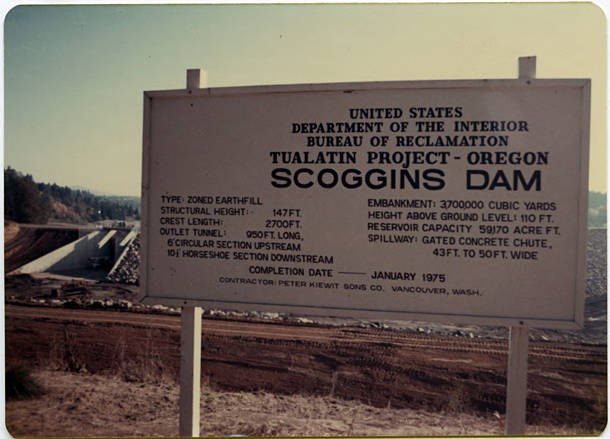
Circa 1972-1975. / Image via Pacific University / Five Oaks Museum Collection
Some pioneer homes were moved up the surrounding hills to be lived in again on new sites. Others were razed, like the schoolhouse, or burned. My Uncle Don and Aunt Nancy chose to buy land closer to Forest Grove for their dairy and horse businesses. Feelings were mixed. Property owners would be compensated by the State of Oregon, but at what cost? Like the Scotts, families like the Sains, Knox's, Mattesons, and Herrs had lived in Scoggins Valley for over 100 years. How do you respond when given no choice?

The Washington County News Times, April 1971. / Image via / Ken Bilderback
"When dealing with the government, you either cooperate or lose it...like Scoggins Valley residents when Hagg Lake went in. I was at the first [US Dept. of Fish and Wildlife] meeting at the old gym. I started to cry as I listened to them try to tell the long-time farm families how important ducks [and other water fowl] were. Sad memories all around." --D.B., Gaston History Squad, 2017
As my great-uncle, Hiram Scott bitterly stated in the above 1971 interview with the Washington County News Times, "There's no use talking about it now...It is foolish to spoil our valley."
Old Family Grave Sites Were Discovered and Exhumed
"My dad was a surveyor on this project- that’s what brought our family to Oregon in 1968.
When they were working that site, putting in the spillway, a pioneer gravesite was uncovered. Work stopped on the project and an archeologist from the state came out to do an official historic survey and remove remains to be reburied later with a monument. My sisters and I were able to go out with Dad and Mom and do some sifting for artifacts. We found casket nails and a metal button. Long time ago!!!" --L.K., Gaston History Squad, 2021
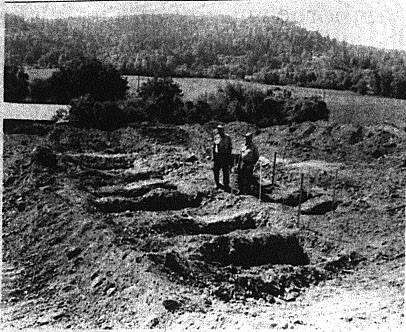
Pioneer graves of the Baker family, early settlers of Scoggins Valley. / Image via / Forest Grove News Times
Those burials were likely the Baker Family. They were removed for reburial to Forest View Cemetery in Forest Grove on September 16, 1971. Likely we will never know if more sites like this one went undiscovered, which perhaps led to rumors that persisted over the years. The very same ones I heard whispered as a child; that bodies and ghosts still haunt Hagg Lake.
Scoggins Valley and Henry Hagg Lake Today: A Popular Fishing and Swimming Spot That Still Claims Lives

Image via / Facebook / Hagg Lake
Hagg Lake is still owned by the U.S. Bureau of Reclamation and is maintained and operated by Washington County. The Park features numerous picnic areas, two boat launching facilities, a fully stocked lake for fishing, more than 14 miles of hiking trails, and observation decks for wildlife and bird watching.
Hagg Lake has been the site of several summertime drownings in the past decade. There was 2014 when three generations of a Hillsboro family -- ages 3 to 42 -- drowned after arriving at the lake to picnic and swim. In 2017, a 68-year-old Hillsboro man drowned while swimming in the lake with a friend. Yet again in 2021 two lives have been taken, Satoru Kamoshita, 61, drowned after he went swimming while kayaking on the lake, and Christopher Farmer, 51, who was training for a triathlon with a group.
The deaths of 3-year-old Jeremy Scholl and his family in 2014 were especially heartbreaking, prompting officials and friends of Hagg Lake to take action for swimming safety and education. Several life jacket stations can now be found around the lake with vests in all sizes available for kids and adults.

Hagg Lake Life Jacket Station. / Image via / Facebook / Hagg Lake
In many ways, Hagg Lake has become what was proposed sixty-some years ago. It provides drinking water to local communities, a popular recreation spot for humans, and a habitat for native Oregon species of flora and fauna. As the old adage goes, nothing is lost without some small gain, but my mind still wanders to what could have been. Where and what would my family be today had history not intervened? The ghosts of Henry Hagg Lake are not spirits, rather the memories of the generations of folks who made their lives in Scoggins Valley.

The original Forest Dale School bell, donated by Marion Matteson, hangs in the picnic shelter of Scoggins Valley Park. / Image via / Facebook / Ken Bilderback
For more images of rural Scoggins Valley and Henry Hagg Lake before dam construction, visit Pacific University's Online exhibit: https://heritage.lib.pacificu.edu/s/exhibits

